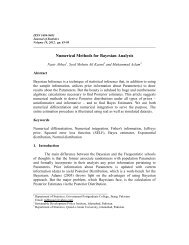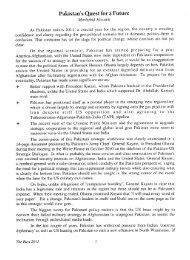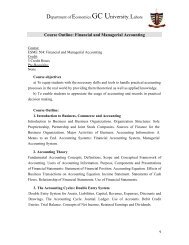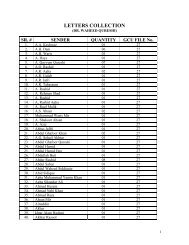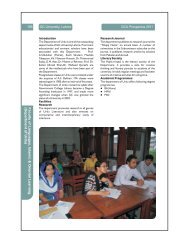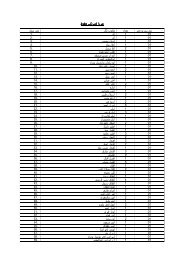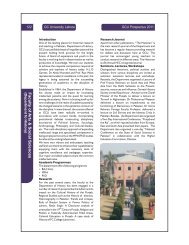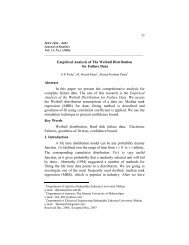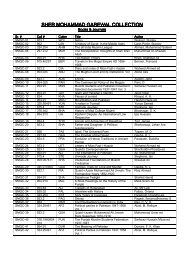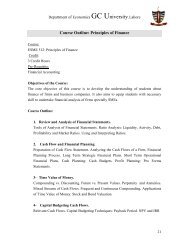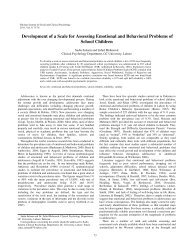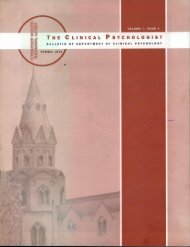Full Text PDF - Government College University
Full Text PDF - Government College University
Full Text PDF - Government College University
Create successful ePaper yourself
Turn your PDF publications into a flip-book with our unique Google optimized e-Paper software.
The Scientific Ravi 2012<br />
Statistics<br />
Test of significance<br />
Aamir Sanaullah<br />
Lecturer, Department of Statistics<br />
GCU, Lahore<br />
The results of analysis and interpretation of the<br />
results of our study should be related to the<br />
objectives. We may find some interesting<br />
results. For example, in a study on smoking, we<br />
may find that 30% of the men included in the<br />
sample are smoking more than four cigarettes a<br />
day compared to only 20% of the women. How<br />
can we interpret this result?<br />
The difference of 10% might be a<br />
TRUE DIFFERENCE, which is also<br />
existed in the total population from<br />
which the sample was taken.<br />
The difference might be DUE TO<br />
CHANGE. In reality, there is no<br />
difference between men and women, but<br />
the sample of men just happened to<br />
differ from that of women. One can also<br />
say that the observed difference is due to<br />
sampling variation.<br />
The third possibility maybe due to<br />
defects in the study design (also<br />
referred to as BIAS). For example, only<br />
male interviewers may have been used<br />
or the pre-test might have been omitted.<br />
May be with an appropriate study design<br />
no such difference would be found.<br />
If we think that this observed difference between<br />
two groups cannot be explained by bias, we will<br />
check out whether this difference can be<br />
considered as a true difference or not. We only<br />
conclude that this is the case if we can explain<br />
this chance of occurrence. We accomplish it by<br />
applying a significance test.<br />
N.M. Kapoor once said, “Procedures which<br />
enables us to decide, on the basis of sample<br />
information, whether to accept or reject<br />
hypothesis or to determine whether observed<br />
sampling results differ significantly from<br />
expected result are called tests of significance,<br />
rule of decision or test of hypothesis.”<br />
“A significance test may be defined as the<br />
probability of obtaining a statistic as different or<br />
more different from the null hypothesis (given<br />
that the null hypothesis is correct) than the<br />
statistic obtained in the sample. If this<br />
probability is sufficiently low, then the<br />
difference between the parameter and the<br />
statistic is said to be statistically significant”<br />
How The Test Of Significance Works!<br />
Procedure of significance test can be<br />
summarized in following steps below<br />
1. We state our hypothesis (statistical<br />
hypothesis, null hypothesis).<br />
2. Decide level of significance.<br />
3. Choose suitable test statistic.<br />
4. Complete required calculation from<br />
the selected sample/probability form.<br />
5. Complete the results / calculated<br />
probability from sample information<br />
with alpha level.<br />
6. Conclusion.<br />
7. Interpretation.<br />
TYPE 1 AND TYPE 2 Errors (Which One Is<br />
Worse Off?)<br />
There is always a possibility of mistake made by<br />
the researcher even in their best projects,<br />
concerning relationship between the two<br />
variables. There are two types of errors.<br />
“The first is called a Type 1 error. This occurs<br />
when the researcher assumes that a relationship<br />
exists when in fact the evidence is that it does<br />
GC <strong>University</strong> Lahore Page 189
The Scientific Ravi 2012<br />
Statistics<br />
not. The probability of committing a Type 1<br />
error is called alpha.”<br />
“The second is called Type 2 error. This occurs<br />
when the researcher assumes that a relationship<br />
does not exist, when in fact the evidence shows<br />
that it does. The probability of committing Type<br />
2 error is called beta.”<br />
If we reduce the possibility of committing Type<br />
1 error, this may result an increase in the<br />
possibility of committing a Type 2 error and<br />
vice versa.<br />
Things may be worse off than before, when<br />
chances to verify that a relationship exists is<br />
missing; the researcher generally tries to<br />
minimize the Type 1 error. But in Type 2 error,<br />
there is nothing worse than before, when chance<br />
to verify that a relationship exists has been<br />
missed by the researcher.<br />
Let’s take an example. In this example, which<br />
type of error would you think that you would<br />
like to commit?<br />
“Someone has reduced crop yields in County X,<br />
for making it eligible for the <strong>Government</strong><br />
disaster relief.”<br />
“Someone has not reduced crop yields in County<br />
X, for making it ineligible for <strong>Government</strong><br />
disaster relief.”<br />
If the researcher has committed Type 1 error,<br />
then the County would be assumed to qualify for<br />
tragedy release or “disaster relief”, when it<br />
actually wasn’t eligible (the null hypothesis has<br />
been rejected, as it should be acknowledged).<br />
The <strong>Government</strong> may be spending disaster relief<br />
funds when it should not, and taxes may be<br />
increased.<br />
If the researcher has committed Type 2 error,<br />
then the County would be assumed to be<br />
disqualified for tragedy release or “disaster<br />
relief”, although it was eligible (we have<br />
rejected the null hypothesis, when it should be<br />
acknowledged). The <strong>Government</strong> may be not be<br />
spending disaster relief funds when farmers<br />
needed it.<br />
A Probability Of Error Level (Alpha Level):<br />
Researchers normally presume that they may be<br />
able to agree with what is called the probability<br />
of committing Type 1 error, i.e., the value of<br />
alpha. Mostly value of alpha is taken as 0.05<br />
in Social Sciences.<br />
An alpha of .01 is not unusual in researches<br />
regarding the public health, because<br />
researchers don’t want to be incorrect more<br />
than 0.1% times.<br />
Good Analyst and Bad Analyst by Gerard E.<br />
Dallal<br />
Reject the hypothesis under test, if an observed<br />
significance level (P value) is less than 0.05. Do<br />
not discard the null hypothesis, if it is higher<br />
than 0.05.<br />
Frequently, researchersare distracted by<br />
statistical significance and ignore practical<br />
significance, meaning, the result that is<br />
statistically significant might be a reason of<br />
happiness, even if it does not have such<br />
importance.<br />
A badresearcher wants a P-value and gives no<br />
importance to the quality of the data. He only<br />
considers P0.05 with and does not<br />
pay much attention for the background in which<br />
the data were collected or the confidence<br />
intervals.<br />
A good analyst considers all the rules of firstclass<br />
study design. He knows that which test<br />
procedure is required for the resulting P value to<br />
be applicable. He takes the P value as<br />
GC <strong>University</strong> Lahore Page 190
The Scientific Ravi 2012<br />
Statistics<br />
significant element of the study, but not as a<br />
whole answer.<br />
Significance tests are just pieces of the<br />
problem, not a whole answer to rely on.They<br />
become unrelated if the outcome has no realistic<br />
significance. One may say that significance tests<br />
are useful pieces of problem.<br />
If some relationship between two variables<br />
exists, then there is a good possibility that<br />
findings are correct. But statistical significance<br />
is not the same as practical significance.<br />
Statistical significant findings might not have<br />
important practical implication. They may have<br />
such finding, but implication of such findings<br />
may be useless. The researcher must look at<br />
both significances, statistical and practical,<br />
for any research.<br />
“However, they do not assure that the<br />
research has been carefully designed and<br />
executed. In fact, tests for statistical<br />
significance may be misleading, because they<br />
are precise numbers. But they have no<br />
relationship to the practical significance of<br />
the findings of the research.”<br />
*LAUGHTER BEST MEDICINE*<br />
Sometimes, because of large sample size those<br />
differences are small but statistically<br />
significant. And the differences would not be<br />
enough to be statistically significant in a small<br />
sample size.<br />
Conclusion:<br />
“Tests for statistical significance are used to<br />
estimate the probability that a relationship<br />
observed in the data occurred only by<br />
chance; the probability that the variables are<br />
really unrelated in the population. They can<br />
be used to filter out unpromising hypothesis.”<br />
We use these tests because they make up<br />
a measure, which explain about the unwritten<br />
and understood results by many people, and<br />
these results present necessary and vital<br />
information about a research project which<br />
can be in contrast with the conclusions of the<br />
other project.<br />
Probability<br />
And Everyday Life<br />
Zeeshan Ali Shams<br />
People usually make statements that are<br />
uncertain. A student who is not good at a<br />
particular subject; after taking an exam of that<br />
subject says that he is not sure whether he can<br />
pass the exam or not. Assume a cricket match is<br />
going to be played between Pakistan and India;<br />
each team has an equal chance of winning or<br />
losing. Likewise, if a man applies for a specific<br />
job, there is a 50% chance of his selection. All<br />
such uncertain statements are related to the topic<br />
GC <strong>University</strong> Lahore Page 191
The Scientific Ravi 2012<br />
Statistics<br />
of Probability. In this article, I shall try to<br />
exhibit the role of probability in everyday life.<br />
What probability is?<br />
Chance, likelihood, percentage and proportion,<br />
alternative terms of probability, are used by<br />
people in everyday life, but they rarely know<br />
what probability is?<br />
The word ‘probability’ has been derived from<br />
the word probable.This means likely, chance,<br />
possible or feasible. Likewise, probability<br />
implies the chance or occurrence of something.<br />
This something, in statistical language, is called<br />
an event. Thus, in statistics, the likely of<br />
happening of an event is recognized as a<br />
probability of that event. Such events ought to<br />
result in stochastic experiments. Stochastic<br />
experiments mean experiments that give<br />
different results when repeated again and again,<br />
under the same conditions. Tossing a wellbalanced<br />
coin, throwing a favorable dice and<br />
drawing a card from a well-shuffled pack of<br />
deck are instances of stochastic experiments.<br />
What does mean by the likelihood of the<br />
occurrence of an event?<br />
The likelihood of occurrence of an event means<br />
the probability of that event. For understanding<br />
this, consider a simple instance of tossing a coin.<br />
When a well-balanced coin is tossed, the chance<br />
of appearing either head or tail is one out of two.<br />
While throwing a well-balanced dice, the<br />
likelihood of occurrence of all points (1, 2, 3, 4,<br />
5, 6.) is equal, one out of six. Similarly, the<br />
likelihood of drawing a king from a wellshuffled<br />
pack of duck is four out of fifty two.<br />
With the help of above instances, this may be<br />
inferred easily that the likelihood of happening<br />
of an event (probability of an event) means<br />
the number of possibilities of the occurrence<br />
of that particular event out of the total<br />
possibilities. If the likelihood of occurrence of<br />
an event is impossible, its probability will be<br />
zero. e.g. the probability of occurring 14, when a<br />
well-balanced pair of dice is thrown, is zero. If<br />
the likelihood of occurrence of an event is<br />
certain, its probability will be exactly one. This<br />
means, in statistical terminology, probability is a<br />
number from 0 to 1 or from 0% to 100%.<br />
Probability in Everyday Life<br />
Probability plays an important role in everyday<br />
life. We are often affected by probability.<br />
Suppose you heard in news that there is a<br />
possibility of rain today. Weather report says<br />
that there is 80% likelihood of rain. If you have<br />
some plans for going on trip in some park, will<br />
you continue to stick to your plan after listening<br />
to the news or cancel your plan for another day?<br />
Surely, your answer will be in negative. But it is<br />
interesting to know how this forecast is made.<br />
The meteorologists provide such forecasts after<br />
calculating probabilities. The way of calculating<br />
probability is simple. They look back in the<br />
history and collect data of similar weather<br />
conditions. Then, the probability of rain is<br />
determined from the formula: the number of<br />
days it rained in past divided by the total<br />
number of days having similar weather<br />
conditions. Take an instance, there is data of one<br />
hundred days having similar weather conditions.<br />
There were eighty days when it rained out of one<br />
hundred. Thus, the probability of raining today,<br />
when weather has almost similar conditions as it<br />
had in past one hundred days, is eighty divided<br />
by hundred, that is, 80%.<br />
It is human nature that they want to be<br />
successful within a very short span of time. Most<br />
of people want to be millionaire or even<br />
billionaire within a single night. For this<br />
purpose, one of the most adopted ways is to try<br />
their lucks in lottery tickets. But do they really<br />
know what the chances of their winning are?<br />
Surely, they do not know. If they know, very<br />
few of them will opt this way. The chance of<br />
winning a lottery ticket is determined after<br />
GC <strong>University</strong> Lahore Page 192
The Scientific Ravi 2012<br />
Statistics<br />
dividing it with the total number of lottery<br />
tickets. Suppose if there are one hundred lottery<br />
tickets, the likelihood of winning a lottery ticket<br />
is one out of one hundred. If there are one<br />
thousand lottery tickets, the likelihood of<br />
winning grand prize is one out of one thousand.<br />
This shows that the chances of winning are<br />
lesser when there are one thousand lottery<br />
tickets instead of one hundred. This is only an<br />
instance, but in real life there are thousands of<br />
lottery tickets. So the likelihood of winning the<br />
grand prize can be determined in the similar way<br />
which implies almost impossible.<br />
Above two instances show the influence of<br />
probability in our daily life. There are hundreds<br />
of instances in our everyday life where<br />
probability affects our plans. This subject also<br />
plays a vital role in economics, management,<br />
operational research, astronomy, physics,<br />
psychology, sociology and many other<br />
disciplines. Many business decisions are also<br />
affected by probability. Almost all entities make<br />
their policies by using probability. Many<br />
forecasts depends upon the likelihood. In short,<br />
every decision that is made without hundred<br />
percent certainties leads to probability. In other<br />
word, lack of certainty gives birth to probability.<br />
Avoid Common Misconceptions regarding<br />
Probability:<br />
I have seen many people making common<br />
mistakes regarding probabilities. It does not<br />
matter what type of information or data was<br />
collected or by which technique the researcher<br />
calculated probability (Subjective approach or<br />
Objective approaches: classical approach,<br />
relative frequency approach, axiomatic<br />
approach).<br />
This section will help to eliminate some<br />
misconceptions about probability that are<br />
usually made by some people.<br />
If there are merely two outcomes of a stochastic<br />
experiment, one must give both two equal<br />
chance occurrences. If one tosses a wellbalanced<br />
coin, then either the head or the tail<br />
will appear on the upper face. Thus, there is<br />
equal likelihood of occurring of head and tail on<br />
a well-balanced coin. If on the first toss head<br />
appears, it does not mean that in the second toss<br />
tail will be appeared because head has already<br />
been appeared. On the second toss, again, both<br />
outcomes (head and tail) has 50-50 percent<br />
chances to appear. Likewise, one should allot<br />
equal likelihood of occurrence to all possible<br />
outcomes. For instance, once I asked one of my<br />
friends, “what is the likelihood of Pakistan<br />
cricket team winning in the semi-final?” He<br />
replied that it depends on how Pakistan would<br />
perform on that day. Perhaps, he thought that he<br />
was right. But, in statistical language, he was<br />
quite wrong. Since there are three possibilities of<br />
the results: Pakistan wins, other team wins or<br />
match ends at draw. Thus, the chance of winning<br />
or losing the semi-final of both teams is one out<br />
of three. Also, the likelihood of drawing the<br />
match is one out of three.<br />
Another misconception often observed is to<br />
think about the patterns. For instance, one<br />
throws a dice fifteen times and finds outcomes<br />
as 2,4,6,1,3,5, 2,4,6,1,3,5, 2,4,6. If he asks his<br />
friend, what the next point may be? Surely, if his<br />
friend does not know about the probability, he<br />
will reply that the next point would be 1. But it<br />
is not the case. Above pattern occurred just by<br />
chance. The next point may be any one of 1, 2,<br />
3, 4, 5,6. Since statistics deals with stochastic<br />
experiments, we know the total possible<br />
outcomes before performing the experiment; but<br />
which outcome will occur cannot be said with<br />
surety.<br />
GC <strong>University</strong> Lahore Page 193
The Scientific Ravi 2012<br />
Statistics<br />
Rana Faizan Ahmed<br />
STATISCAL<br />
HYPOTHESIS<br />
In order to understand the term, we need to<br />
know firstly that what Statistical hypothesis is?<br />
Hypothesis, as we know is simply the base of<br />
any investigation, so Statistical Hypothesis is an<br />
assumption about the population parameter<br />
(measuring characteristic), that either our<br />
assumption is true or not. Normally statisticians<br />
use hypothesis testing to check whether to reject<br />
the statistical hypothesis or not. The hypothesis<br />
testing includes 6 steps that are:<br />
1. Hypothesis<br />
2. Level of significance<br />
3. Test statistic<br />
4. Critical region<br />
5. P-value<br />
6. Interpretation<br />
These are the steps which a Statistician must<br />
follow for testing, but we won’t discuss the<br />
detail of hypothesis testing anymore. The<br />
statistical hypothesis should be performed on the<br />
whole population and if it is performed using a<br />
random sample than results might not be true,<br />
because data is very important to Statisticians<br />
and if it’s not consistent, then there will be<br />
errors may lead to a false decision. Generally<br />
hypothesis may be simple or composite, the<br />
examples are:<br />
<br />
<br />
The mean score of Pakistan in T 20s is<br />
130 (Simple hypothesis).<br />
The Average scoring of students in the<br />
test of Statistics is 60 (Simple<br />
hypothesis).<br />
<br />
<br />
The mean score of Pakistan in T 20s is<br />
greater than or equal to 130 (composite<br />
hypothesis).<br />
The average scoring of students in the<br />
test of Statistics is less than or equal to<br />
60 (composite hypothesis).<br />
It is a fact that in any situation there are two<br />
different results e.g. Pakistan will either win the<br />
match lose, Ali will either fail or pass the exam<br />
or Sana will be declared as a position holder or<br />
not etc.<br />
So, we can say that statistical hypothesis is the<br />
statement that explains about relationships, like<br />
all hypotheses, Statistical hypotheses may<br />
predict truly or not. In making decisions,<br />
statistical hypothesis uses the testing approach<br />
called hypothesis tests. (As discussed above)<br />
In statistical hypothesis, the decision making<br />
depends on the data. Data should serve as a<br />
representative, if doesn’t, our decision might not<br />
be true. In decision making, we will set up a<br />
scheme between the matching and mismatching<br />
of Reality, we believe the true or false<br />
hypothesis is the reality. Here we uses the phrase<br />
“Do not reject H0” Or “Reject H0” which means<br />
the two right decisions that match the reality and<br />
two wrong decisions that do not, are;<br />
<br />
<br />
<br />
<br />
Hypothesis is true and we will not reject<br />
H0<br />
Hypothesis is false so we will reject H0<br />
Hypothesis is true but we won’t reject<br />
H0<br />
Hypothesis is false but we reject H0<br />
DECISION H0 is true H0 is false<br />
Accept H0: satisfactory error<br />
Reject H0: error satisfactory<br />
The mismatching of decisions constitutes an<br />
Error as our data is not like as it should be.<br />
GC <strong>University</strong> Lahore Page 194
The Scientific Ravi 2012<br />
Statistics<br />
Errors have very bad effects on our real life,<br />
because an error leads us to commit more errors.<br />
So, in statistical hypothesis we have to focus<br />
more seriously on errors and make arrangements<br />
that it will be rejected when it is true, which<br />
means if there is an error, the hypothesis must be<br />
rejected. Now we will discuss two types of<br />
hypothesis:<br />
Two types of Hypothesis:<br />
<br />
Null hypothesis (H0 is true but rejected)<br />
The hypothesis against which we hope to gather<br />
evidence is called the NULL HYPOTHESIS<br />
denoted by H0.<br />
The definition can be cleared through this<br />
example; “let us suppose that the Judge has to<br />
make a decision that either a person is guilty or<br />
not, his decision would be based on evidences.<br />
For this, he would assume that both of them are<br />
not guilty. Then when the case would start,<br />
every lawyer would give evidences that his<br />
client is not guilty. After evidences given by<br />
both lawyers, the judge would decide that who is<br />
guilty. If he gives a decision that a person is<br />
guilty who actually hadn’t committed the crime<br />
and is sentenced to death, then this is just like<br />
Null hypothesis (H0 is true but rejected, means<br />
he hasn’t actually committed that but according<br />
to the given evidences he was found guilty. As<br />
the lawyer of the person who commits crime,<br />
gave evidences and got his client saved).<br />
H0 = committed crime but saved<br />
H = won’t committed crime but sentenced to<br />
death<br />
In accordance with the above example, a person<br />
who didn’t commit the crime was sentenced to<br />
death, this is what Alternative hypothesis is (in<br />
actual, he didn’t commit but got punished).<br />
Here the error occurred in making the right<br />
decision, why? The evidences presented might<br />
not be true. Those errors are referred to as Type<br />
I and Type II, which will be discussed later.<br />
Now I will describe these types of Hypothesis<br />
through a scheme, it is:<br />
Decision:H0 is true<br />
Accept H0: satisfactory<br />
Reject H0: Type I error<br />
H0 is false<br />
Type II error<br />
satisfactory<br />
So, from this scheme it turns out that we are<br />
making a decision about a belief that what’s the<br />
truth and what’s not regarding the hypothesis.<br />
Now, let’s see what this scheme says to us,<br />
firstly “reject H0 means that I have decided to<br />
reject H0 as it is false but it does not mean H0 is<br />
actually false because it’s our decision.<br />
Similarly, “accept H0” means that I have<br />
decided to accept H0 (do not reject), as it is true<br />
but, it does not mean that H0 is true, in actual.<br />
There are some errors which are big obstacles in<br />
making good decisions. These errors are named<br />
as type I error and type II error as already<br />
mentioned above.<br />
Type I error (Reject H0 when it is true, Not<br />
believing the truth)<br />
Type II error (Accept H0 when it is False,<br />
Believing the untruth)<br />
<br />
Alternative Hypothesis (H0 is false but<br />
accepted)<br />
Type I error:<br />
The hypothesis for which we wish to gather<br />
supporting evidence is called the alternative<br />
hypothesis, and is denoted by H1.<br />
GC <strong>University</strong> Lahore Page 195
The Scientific Ravi 2012<br />
Statistics<br />
The above mentioned graph shows type II error,<br />
in which the value of variable x is in the region<br />
of known population, and it is in the critical<br />
region, that’s why we will accept the Alternative<br />
Hypothesis. But it is not from known population<br />
as it is under the curve of Unknown population.<br />
This graph shows us that the value of a variable<br />
‘x’ is falling out of the region by 5 percent. So,<br />
we will reject Null hypothesis because the value<br />
does not fall in the acceptance region, it will be<br />
more clear through another graph.<br />
This region is called beta, the probability of<br />
Type II error.<br />
This graph shows us that the region represented<br />
by x is now under the curve of an unknown<br />
population, it still lies under the same curve of<br />
Known Population but the value is beyond the<br />
critical region so it will be rejected because we<br />
are not accepting the values of this range.This<br />
area is called Alpha (α), the probability of type I<br />
error. We will reject the null hypothesis in this<br />
case.<br />
Type II error:<br />
Type I error is usually delicate and more serious<br />
than that of Type II error, so special care should<br />
be taken in carrying out a hypothesis. These<br />
errors would not be eliminated but reduced so;<br />
reduction of these errors might lead us to the<br />
right decision. Type I error is called False<br />
positive and type II error is also called False<br />
negative.<br />
Example regarding Type I and Type II errors:<br />
Suppose that you have an appointment with the<br />
doctor and the doctor tells you that you are<br />
suffering from a sore throat, but in actual you<br />
are not. This will be a type I error which simply<br />
shows an effect, whenever a test is performed.<br />
Similarly opposite to this situation will be a type<br />
II error. That’s all about the Statistical<br />
hypothesis and it should be considered in<br />
hypotheses for making right decisions.<br />
GC <strong>University</strong> Lahore Page 196
The Scientific Ravi 2012<br />
Statistics<br />
.Statistics - Explained<br />
In a Magnifying Glass!<br />
A Case of NIKE Shoes<br />
Qurat-ul-Ain<br />
When we talk about numbers /integers /order /<br />
analysis, the first word that clicks in our mind is<br />
MATHEMATICS or STATISTICS. Both the<br />
words originated from Latin / Greek words.<br />
STATISTICS refers to a systematical<br />
arrangement of numerical facts. Or we can also<br />
describe Statistics as “a discipline which<br />
includes procedures, techniques, inferences and<br />
making hypothetical statements to reach a<br />
decision in the face of any uncertainty.” For<br />
example, in Vital Index Theory, we have birth<br />
ratio, death ratio and other ratios pertaining to<br />
population and gender.<br />
Let me tell you where and to what extent<br />
Statistics and statistical concepts influence<br />
decision making at various national centers. In<br />
the weather radar station, we have hypothetical<br />
statements about weather conditions pertaining<br />
to whether; it would rain or not or whether it<br />
would be cloudy or sunny. In the head quarter of<br />
geology, we find anticipation and forecast in<br />
terms of confirmation about the earthquakes,<br />
tsunami, floods and storms. Their intensities are<br />
also predicted in the same way. In trade and<br />
commerce, marketing strategies and<br />
management decision largely depend on the<br />
statistics. For instance, descriptive statisticsis<br />
used in the production homes, whereas<br />
inferential statistics come into play when dealing<br />
with concepts and methods concerned with the<br />
summarization and description of important<br />
numerical data. Sometimes these discussions are<br />
based on the whole population or sometimes just<br />
one product is chosen, known as a “sample”.<br />
Let’s have a very practical yet common example<br />
which is based on our daily routine life; the<br />
footwear. I know the questions which are just<br />
coming to your mind that how small and<br />
everyday use stuff like “shoes” can carry<br />
Statistics with it? Now let me tell you how<br />
important role does stats play in small matters to<br />
the greater ones.<br />
When a production house / production<br />
management aims to launch a new product or a<br />
new range of its existing product, it carries out<br />
extensive research. During the research phase,<br />
descriptive stats is used. Production persons<br />
carry out data analysis, gather data sources,<br />
prepare dichotomous and multiple choice<br />
questionnaires and set down time frame and a<br />
sampling frame to perceive correctly what<br />
market requires, and how well their new product<br />
can cater to the needs of the consumers.<br />
Questionnaire is of two types, open ended<br />
(which allows respondents to answer in his/her<br />
own way, which are sometimes difficult to<br />
tabulate and interpret) and closed ended (all the<br />
answers are pre-specified and can easily be<br />
interpreted and tabulated). Ideally, the<br />
combination of both types is considered as the<br />
best way to collect primary data. On the rating<br />
scale, we basically describe the response on<br />
scale such as “high, low, satisfied, unsatisfied,<br />
efficient, very efficient, inefficient and etc.” The<br />
marketing research must define target<br />
population, and the time frame describes the<br />
time and duration for which the survey should<br />
be conducted.<br />
For setting out the sampling frame, samples are<br />
chosen. Sampling techniques help in choosing<br />
the respondents. In this case, sampling is done<br />
on the basis of probability sampling. In the<br />
probability sampling design, the sampling<br />
design is chosen as stratified sampling, because<br />
sampling includes different age groups / gender /<br />
profession etc.<br />
Here for better understanding and in order to<br />
keep reader’s interest, I would include an<br />
GC <strong>University</strong> Lahore Page 197
The Scientific Ravi 2012<br />
Statistics<br />
example of favorite sports wear ‘NIKE’. From<br />
data analysis and primary research, we found out<br />
the reason which contributes towards the low<br />
sales of NIKE footwear among ‘women’. One<br />
reason is the poor marketing and promotional<br />
strategies for ladies’ shoes as compared to men’s<br />
variety. Unfamiliarity is also another major<br />
reason for the low sales of NIKE ladies’ shoes.<br />
After this, data of the management structure was<br />
gathered from the information through<br />
secondary data, recent developments, the<br />
company profile, consumer perception and<br />
behavior, future plans, competitors, trend and<br />
product profile which was then analyzed.<br />
Having collected that, the management made an<br />
‘Executive Summary’.<br />
Afterwards, a theoretical framework was<br />
prepared to analyze the dependant and<br />
independent factors. With respect to NIKE<br />
ladies footwear, a statistical study shows that<br />
lack of proper marketing, planning, plus high<br />
cost, low affordability for middle and lower<br />
classes and lack of knowledge are the main<br />
independent factors for low sales. Here ‘low<br />
sale’ is a dependent factor.<br />
Now we make a hypothesis development:<br />
Interviewing and Moderating Variables:<br />
Null and Alternative Hypothesis:<br />
H0: MSS = 0<br />
H1: MSS ≠ 0<br />
H0: improvement in sale strategies will not<br />
cause any improvement in sales of ladies shoes.<br />
H1: improvement in sale strategies will cause an<br />
improvement in sales volume of NIKE ladies<br />
shoes.<br />
The data generated by using primary research<br />
method, through questionnaires, is then<br />
processed on SPSS (statistical program). The<br />
data can then be presented as follows:<br />
Areas of<br />
Behavio<br />
r<br />
Know<br />
how<br />
about<br />
Nike<br />
Shoes<br />
Advertis<br />
ement<br />
likelines<br />
s<br />
Before<br />
and<br />
After<br />
sale<br />
service<br />
Highly<br />
Dissati<br />
sfied<br />
Dissati<br />
sfied<br />
Satis<br />
fied<br />
1 2 3 4<br />
1 2 3 4<br />
1 2 3 4<br />
High<br />
ly<br />
Satis<br />
fied<br />
In the sample of 50, 5% responded as<br />
‘satisfied’, while 3% as ‘highly dissatisfied’.<br />
Then, data processing methodology was used as<br />
data was random. In data analysis, there were;<br />
demography of respondents, CIL, shopping<br />
season, brand collection, factors and forces<br />
influencing comparison with other bands. The<br />
data was then presented with the help of bar<br />
charts and pie charts which ultimately helped<br />
management in the decision making process<br />
before, launching its new product in the market.<br />
In the end, I would like to say that statistics is<br />
not just about counting numbers on fingertips.<br />
Instead, it is about the manipulation of data in<br />
different fields based on your daily routine life.<br />
The sample data selection support H1 and reject<br />
H0. We can use α = 0.05 and z-test of H1 as<br />
sample size is more than 30.<br />
GC <strong>University</strong> Lahore Page 198
The Scientific Ravi 2012<br />
Statistics<br />
Does IQ Matter?<br />
Mehvish Rizvi and Samra Qadir<br />
“An intelligence quotient (IQ) is a score<br />
derived from one of several different<br />
standardized tests designed to assess<br />
intelligence. When modern IQ tests are<br />
constructed, the average score within an age<br />
group is set to 100 and the standard deviation to<br />
15. Today almost all IQ tests adhere to the<br />
assignment of 15 IQ points to each standard<br />
deviation (SD), but this has not been the case<br />
historically. Approximately 95% of the<br />
population has scores within two SDs of the<br />
mean, i.e., an IQ between 70 and 130.’’<br />
Regression analysis is also used to understand<br />
which among the independent variables are<br />
related to the dependent variable, and to explore<br />
the forms of these relationships. In restricted<br />
circumstances, regression analysis can be used<br />
to infer causal relationships between the<br />
independent and dependent variables.”<br />
We will check the evidence that Does IQ play<br />
any role in the progress (GPA) of student, that<br />
is,how much the progress of any student<br />
depends upon his IQ?<br />
Here, intelligence and hard work complement<br />
each other. They both work side by side. One is<br />
God gifted and the other requires self<br />
disciplining. Many psychologists say that IQ<br />
does not matter in good progress report; it plays<br />
only a little role as compared to the struggle<br />
made by them.<br />
Now let us define what is IQ?<br />
We have taken an example to check the<br />
relationship between the students’ IQ and their<br />
Progress report (GPA). We can measure this<br />
relationship by Regression Analysis. Now, what<br />
is Regression analysis<br />
“In statistics, Regression analysis includes<br />
many techniques for modeling and analyzing<br />
several variables, when the focus is on the<br />
relationship between a dependent and one or<br />
more independent variables. Regression analysis<br />
is widely used for prediction and forecasting.<br />
We did a research on how IQ levels affect the<br />
GPA of any student and to what extent the GPA<br />
depends upon the IQ level. As statisticians, we<br />
defined our hypothesis “IQ affects the GPA<br />
report” and by using the application of<br />
regression analysis we estimated a regression<br />
line. One advantage of Regression line is that it<br />
tells us the dependence of response variable.<br />
(GPA) on Predictor Variable (IQ):<br />
For this purpose we selected 10 students of<br />
different IQ levels, having different GPA as<br />
well. The data is as shown below:<br />
GC <strong>University</strong> Lahore Page 199
The Scientific Ravi 2012<br />
Statistics<br />
No. of student GPA IQ Level<br />
1 3.40 123<br />
2 3.00 125<br />
3 3.50 118<br />
4 2.89 80<br />
5 3.00 130<br />
6 2.70 101<br />
7 3.70 129<br />
8 3.10 108<br />
9 2.93 105<br />
10 3.02 107<br />
From the above data we have estimated our<br />
regression line “GPA = 1.81 + 0.0117 IQ”. In<br />
this regression line, the dependent variable is<br />
GPA and the independent variable is IQ. This<br />
relationship shows that GPA depends only 1.1%<br />
on IQ levels. Intelligence is only a tool for<br />
success. The main role is played by the ‘hard<br />
work’ done by the student. Now, it’s on him that<br />
how much he uses this tool to move ahead.<br />
In our research, we tested the IQ levels<br />
by a simple IQ test; the results are shown in the<br />
table above. Higher the IQ, higher was the GPA<br />
level. Although intelligence is blessed by<br />
Almighty Allah to which there is no alternative,<br />
but one can improve the results by his own<br />
struggle and hard work. The results can be even<br />
better if we work hard along with using the<br />
intelligence gifted to us.<br />
NEW METRIC FOR OBESITY<br />
Researchers have developed a new metric to<br />
measure obesity, called A Body Shape Index,<br />
or ABSI, that combines the existing metrics of<br />
Body Mass Index (BMI) and waist<br />
circumference and shows a better correlation<br />
with death rate than do either of these<br />
individual measures.<br />
GC <strong>University</strong> Lahore Page 200



